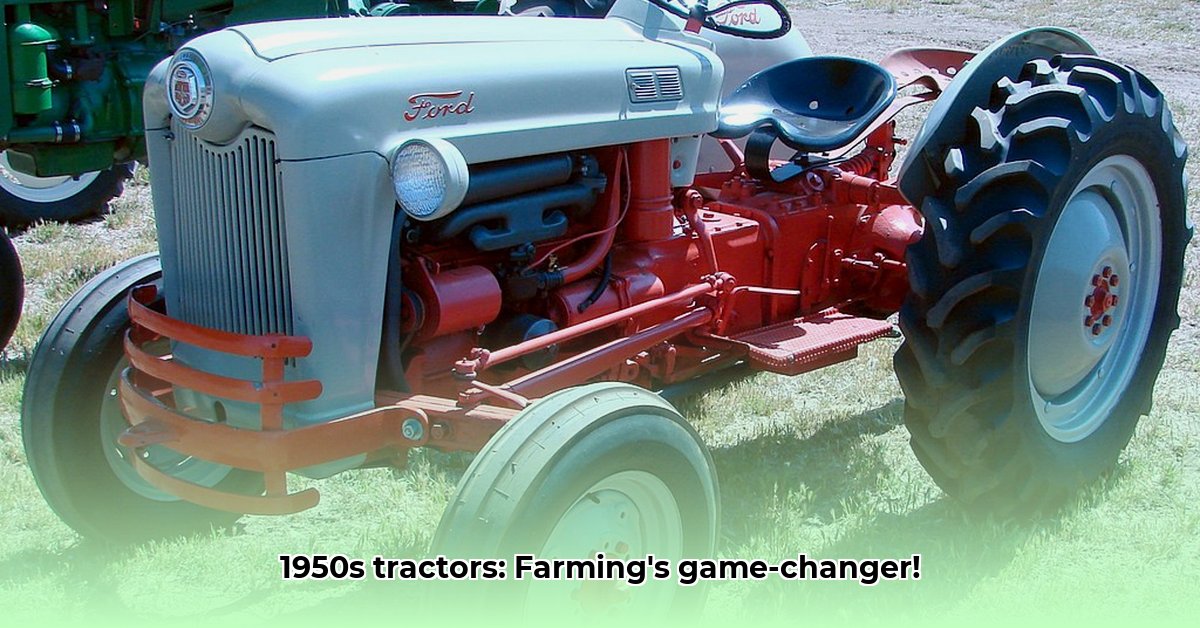
The 1950s witnessed a quiet revolution in agriculture—a shift from horse-drawn plows to powerful, engine-driven tractors. This era saw the rise of iconic machines that forever changed farming, boosting productivity and easing the burden on farmers. This article explores the major players—John Deere, International Harvester, Ford, Allis-Chalmers, and Massey Ferguson—comparing their most significant models and examining their lasting impact. For more on later models, see this page on 80s Deere tractors.
The Big Five: Tractor Titans of the 1950s
Five companies dominated the 1950s tractor market, each offering unique models to suit various farm sizes and needs. The competition fueled innovation, resulting in a diverse range of tractors that shaped modern agriculture. How did these giants differentiate themselves, and which models reigned supreme?
John Deere: The Dependable Workhorse
John Deere, a name synonymous with quality, solidified its reputation with its robust and reliable tractors. These machines weren't flashy, but their dependability and longevity earned them immense farmer loyalty. Models like the John Deere "M" series became iconic, known for their powerful engines and durable construction. Their straightforward design and readily available parts made them a farmer's best friend. Did their reliability outweigh their fuel efficiency? While precise data is scarce, their enduring popularity speaks volumes.
International Harvester: The Versatile All-Rounder
International Harvester (IH) took a different approach, offering a diverse range of tractors, covering everything from small family farms to large-scale operations. Their Farmall line epitomized this versatility, catering to diverse needs and farming styles. Were they as fuel-efficient as their competitors? The answer varies across model years and specific configurations. Their broad appeal, however, underscores their adaptability and market awareness.
Ford: Simple Power, Easy Maintenance
Ford, leveraging its automotive expertise, focused on straightforward designs that balanced power with ease of maintenance. The Ford 8N became a legend, appreciated for its simplicity and readily available parts. Many farmers prized this ease of repair, minimizing downtime and production losses. While potentially less powerful than some competitors, their straightforward nature and ease of maintenance made them very popular. Was this simplicity a trade-off for fuel efficiency? Historical data is limited, but anecdotal evidence suggests a favourable balance.
Allis-Chalmers: Innovation on the Fields
Allis-Chalmers distinguished itself through innovation, regularly introducing cutting-edge technologies to its tractors. While their designs were often complex, they pushed the boundaries of what was possible in agricultural machinery. This focus on innovation, however, might have meant slightly higher maintenance costs. Were these advanced features worth the complexity? The evidence suggests a trade-off between performance and maintainability.
Massey Ferguson: The Up-and-Comer
Massey Ferguson, a relative newcomer in the 1950s, quickly gained market share through cost-effective tractors and a wide distribution network. By offering competitive pricing and accessibility, they captured a significant customer base. Were these tractors less fuel-efficient than others? While data is limited for a precise comparison, this suggests strategic market positioning as a key to their early success.
Comparing the Giants: Strengths and Weaknesses
Direct comparison of fuel efficiency and horsepower across brands is difficult due to the lack of standardized testing data from this era. However, we can assess their relative strengths and weaknesses based on available information, historical accounts, and marketing strategies.
| Brand | Key Strengths | Potential Weaknesses | Typical User Profile |
|---|---|---|---|
| John Deere | Durability, reliability, ease of use, readily available parts | Higher initial cost, potentially lower fuel efficiency in some models | Large-scale farms, farmers valuing dependability |
| International Harvester | Versatility, wide model range, adaptability | Maintenance complexity in some models, variable fuel efficiency | Diverse farm sizes and operations, adaptable farmers |
| Ford | Simplicity, ease of maintenance, readily available parts | Potentially lower peak horsepower in some models, basic design | Smaller to medium-sized farms, farmers valuing simplicity |
| Allis-Chalmers | Technological innovation, cutting-edge features | Increased complexity, potentially higher maintenance costs | Farmers willing to adopt new tech, more mechanically inclined |
| Massey Ferguson | Cost-effectiveness, wide distribution network | Possibly less robust than some competitors, limited data on fuel efficiency | Price-conscious farmers, those needing readily available tractors |
The Lasting Impact: A Legacy in Steel
The 1950s tractors were more than machines; they were agents of societal change. They revolutionized agriculture, significantly increasing efficiency and impacting global food production. Many of these tractors are now highly sought-after collector's items, symbolizing an era of innovation and agricultural transformation. Their impact extends beyond their time; their legacy continues to influence modern farming practices and engineering design.
Key Takeaways:
- The 1950s represented a pivotal era in tractor design and manufacturing, significantly impacting farming and agricultural output.
- Direct horsepower and fuel efficiency comparisons across brands are limited due to a lack of standardized testing data from that period.
- John Deere, International Harvester, Ford, Allis-Chalmers, and Massey Ferguson each offered unique models and marketing strategies to meet diverse farmer needs and preferences.
- Understanding the specific applications and target markets of each model is crucial for evaluating their relative merits. Qualitative factors, including design complexity, availability of parts, and reputation for reliability, all contributed to a brand's success.